How to reach here:
By Air: Khajuraho airport is well connected to many cities in India, like Delhi, Mumbai, Varanasi, Bhopal, Indore, Allahabad and Mumbai.
By Rail: Nearest railway station to Khajuraho is Mahoba which is located at 77 km from Khajuraho. Harpalpur is another nearby major rail head, which is connected to most of the railhead in India. It is nearly 90 km away from Khajuraho.
Best time to visit: October to March.
Languages spoken: Hindi, English.
Must eat: Khoprapak, Seekh Kebab.
Famous Restaurants: Bella Italia, Garden View, Zorba Di Buddha, Bamboori Treat.
Places you must visit:
Vishwanath Temple is located on the north-eastern corner of the western group complex. Housing beautiful marble Shivalinga as a prime deity, the temple is dedicated to Lord Shiva. Apart from the main deity, the interiors of the temples are adorned with the idol of Lord Brahma.Famous for its sculptures, the temple was constructed in 11th century. History also states that the ancient temple at village had four shrines, out of which two can be seen by the tourists. Adding beauty to the shrine, images of lions and elephants can be seen on the southern as well as northern steps of the temple.Another prime attraction of the temple is a 6 ft high Nandi bull, which is seated on top of a wide platform with a sphinx-like expression. The beautifully carved exteriors of the temple are decorated with images of Apsaras to enhance the charm and beauty of this huge temple.

Chitragupta Temple is an ancient shrine located eastwards facing the direction of the rising sun. Constructed in 11th century, the temple is dedicated to Sun God, who is also known as Lord Surya. The temple houses a beautiful 5 ft high standing idol of Lord Surya driving a chariot, which is operated by seven horses.Adorned with beautifully carved walls, the temple presents a view of numerous carvings depicting historic events. The stone carvings of full figured surasundaris, image of Lord Vishnu in the 11 headed form and erotic couples are the prime attractions of the temple. Apart from this, intricate carvings of processions, dancing girls, elephant fights and hunting scenes are also done of the interiors of the temple.Apart from this, the temple also houses a three-storeyed stepped tank, which is another prominent attraction. Popularly known as Chopra, the tank was constructed by Chandela rulers. The exteriors of this beautiful temple are decorated with sculptures of Mithunas, Apsaras, Vyalas and numerous other deities. Apart from these, ascetic figures counting more than seventy are beautifully carved on the balcony panels of the temple.The south wall of the temple displays an eleven-headed Vishnu carving, which possesses ten different avatars of Lord Vishnu. The doorways of the temple portray a series of three similar but smaller figures of Lord Surya, which are also depicted in the main sanctum of the temple.
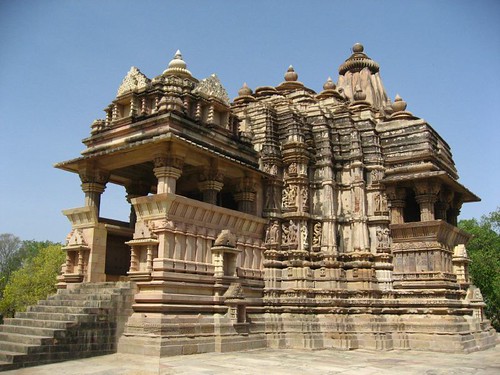


Kandariya Mahadev Temple is not only one of the biggest temples of the western group of temples in Khajuraho, but the first to be constructed on the general platform. Depicting the Chandela art, the huge shrine was constructed in 1025–1050.The temple is dedicated to Lord Shiva, as at the centre of the Garbha Griha, a linga is installed. Beautiful architecture of the temple is based on typical five-part design, which consists of Garbha Griha, Ardhamandapa, Pradakshina and Mahamandapa supported with pillars. The tower present in the temple is more than 100 ft high. Possessing a typical sandstone structure, the main shrine of the temple is decorated with around 800 images, which are mostly 3 ft high. The statues carved around the temple are segmented in three bands, which include images of gods, goddesses, erotic groups, beautiful women and musicians.The borders of the walls are carved with images of elephants and horses, warriors and hunters, acrobats and musicians, dancers and devotees. It is the only local temple, which has preserved two beautifully designed interior 'toranas', both having a delicate design.

Chaunsat Yogini Temple is another ruined temple belonging to the western group temples of Khajuraho. It is believed to be the oldest existing temple in the village constructed around 900 AD. Raised on a platform, the temple is in damaged state and public access is restricted in the area.The name of the temple is derived from the numeral 64, which means Chaunsat in Hindi. Legends state that the temple once had 64 yoginis in its 64 cells, who attended goddess Kali. Further, it is also believed that goddess Kali sheltered herself in the 65th cell. Constructed by using granite ashlars, the entire temple premise is bounded by an open courtyard.


Ghantai Temple is among the three famous Jain Temples represented in Khajuraho. Constructed between 950 and 1050 AD, the Ghantai temple is in ruins. The walls of the temple are beautifully decorated with display of 16 dreams of Mahavira's mother. The temple also has a stone carved image of Mahavira's mother, which is represented as a multi-armed Jain goddess hovering on a winged Garuda. The name of the Ghantai temple is derived from the beautifully carved figures of chain-and-bell, also known as ghanta, on its tall and huge pillars. Apart from this, the temple is also famous for its ornamentation, stately form and classical architectural eastward facing temple possesses the same design as the Parsvanath temple; however, it is larger in its conception and almost twice in its dimensions.

Adinath Temple is situated on the north of the Parsvanath Temple and is one of the important temples of the Jain group of temples in Khajuraho. It is believed that this temple was constructed in the 11th century and was dedicated to Adinath, a Jain saint. This temple was constructed by the rulers of Chandel Dynasty during 950-1150 A.D.With the passage of time, only the sanctum and corridor roofs of temple have survived. The mandapa and porch of the temple was damaged; however, the present entrance is replaced by modern entrance chambers. The arched doorways situated at the entrance are similar to that of the original ones.Constructed on the structure of sapta-ratha, the temple also possesses a single towered shikhara, which makes the shrine beautiful. The walls of this temple are decorated with beautifully carved images and movements and postures of court musicians. The wall carvings also provide the closer view of the dance style of Nilanjana, a famous dancer in the court of Lord Adinath.


State Museum of Tribal and Folk Art is located within Chandela Cultural Complex in Khajuraho. The museum displays Indian tradition and culture, its fusion with foreign cultures, which came into existence through trade and incursion. Housing the rich collection of tribal and folk art and artifacts the museum offers a brief history of custom and rituals of the tribal people.Galleries of the museum display more that 500 representative items of terracotta, wood crafts, jeweler tribal and folk paintings, masks, tattoos and metal crafts. Apart from this, the museum also exhibits evolution of various forms, styles and designs that have transformed and evolved over passed centuries.


Kalinjar Fort is known for its vast collection of monuments and sculptures, which reveals many historic events and practices. Housing numerous temples and structures within it, the fortress represents an architectural expertise of the Chandela dynasty. Similar to other forts, this fort was also constructed by the Chandela rulers at the end of 1st and beginning of 2nd century for protecting their kingdom from enemies.The huge fort is located on the top of a holy hill, which is mentioned in many Hindu scriptures. The fortress was known as Kirtinagar in Satyuga, Madhyagarh in Treta, Singhalgarh in Dwapar and Kalinjar in Kalyuga.The fort was constructed on 25-30 m wide foundation to provide maximum strength to the fort. It has a height of 30-35 m with 8 m wide summit with length of around 7.5 km over the hillock. The fort is constructed using sand stone and granite pieces, which are placed over each other.The name of the fort was coined by using Kalanjar, which is related to the incident of Lord Shiva consuming the poison. It is strongly believed that the place is a holy abode of Lord Shiva. Evidences for the same can be seen in the temple of Neelkanth Mahadev situated within the fort premises. The stone dug ponds and lakes are other attractions of the fort.

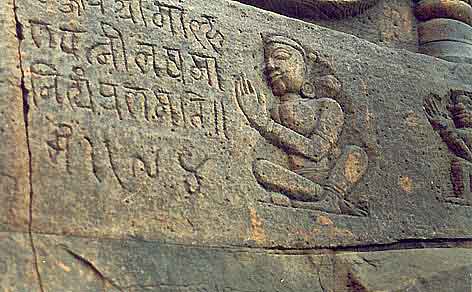
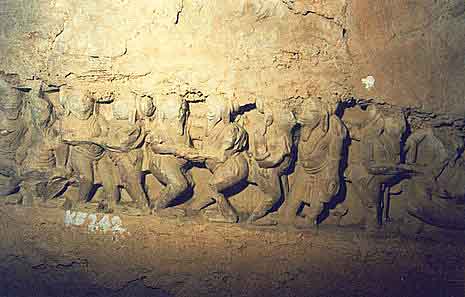
BeniSagar Dam is spread across an area of about 7.7 sq km. The dam is an ideal picnic spot, which is surrounded by trees and river Khuddar flowing through Khajuraho city.

Ajaigarh Fort presents the architectural style followed by Chandela Kings. It is believed that the fortress was constructed by the rulers, when their power in the area was declining. Located at an average elevation of 1,111 m, the fort is mounted on a flat-topped projection of Vindhya ranges.The fort offers a beautiful view of Ken River, which flows within the beautiful destination. Historians state that the huge structure was provided to the fort for protecting natives from attacks and encounters of enemies and outsiders. Presently, the fort can be accessed by its two gates namely Darwaza, situated on the north and Tarhaoni, situated to the south-east.The fort also houses sculptures in a row formation of goddesses called Ashta Shakti. Ajay Pal ka Talao, a famous lake, and the ruins of a Jain Temple are other prominent attractions present within the fort.


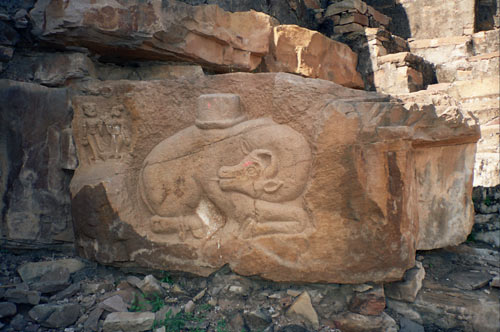
Shilpgram is popular for promoting ancient culture of India in the form of various performances of folk arts. The cultural center sprawls across an area of about ten acres and was established in 1998 by the government to preserve the culture and tradition of the country.



Jain Museum possesses a huge collection of more than hundred ancient Jain sculptures, which were enshrined in the temples of the destination. Established in 1987, the museum in the form of circular building is situated in Jain Temple Complex, which is also known as Sahu Shantiprasad Jain Kala Sangrahalaya.The museum preserves a collection of sculptures of yakshis, statues of 24 Tirthankaras and other figures of Jains. Entrance of the museum is adorned with two ornamented Makara Toranas, which are placed on both sides of the steps.


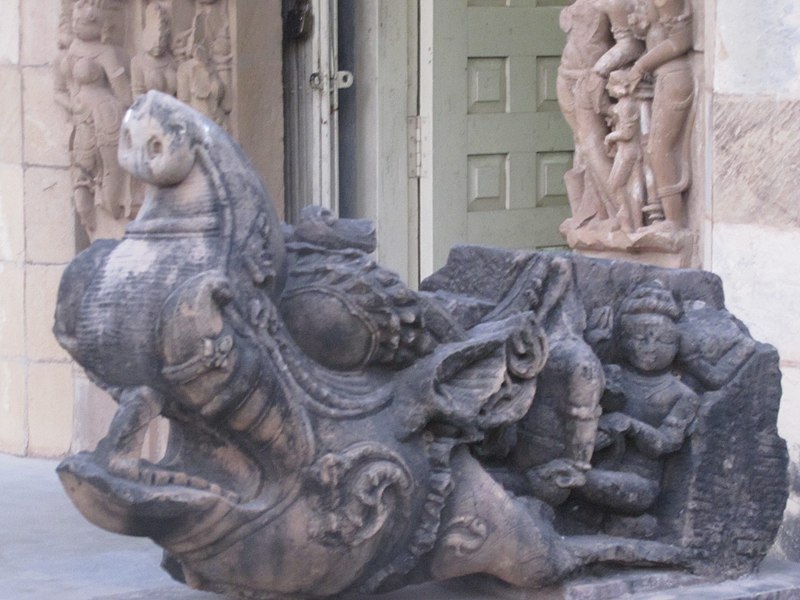
Beejamandal Temple is one of the ruined temples located in Vidisha at Khajuraho. Marked on the top by a white stone, it is believed that the temple was under the stack of earth. The architecture of the temple is influenced by Indonesian or south-east Asian styles. Since ages, the villagers of the destination regularly light the holy oil-lamp each night at this place.The ruins present at this the place depicts that the temple was dedicated to Lord Shiva and goddess Parvati. The exteriors of the temple are decorated with intricately carved stone animals, pillars and walls.

Vaman Temple belonging to the eastern group of temples is dedicated to Lord Vama, the dwarf lord. Being located in the north of Khajuraho, the temple is surrounded by lush green barley fields. The top or the third row of the jangha represents framed niches containing diamonds in the place of sculptures.The architecture of the temple is similar to that of others located in Khajuraho. The temple has a single spire shikhara, a sanctum, a mahamandapa with tangential transepts, an atrium and a porch.


Devi Jagdambi Temple is famous for its Garbha Griha, which is a huge shrine that houses the image of goddess of the Universe, Jagdambi. Surrounded by walls beautifully carved with numerous figurines, the temple is referred to as a delicately balanced temple.The temple was originally dedicated to Lord Vishnu, which is evident from the figures represented in the form of beautiful stone carvings at the bands of the temple. Evidences for the same include intricately carved panels with the images of Lord Vishnu and his avatars on the two lower bands of the shrine.Later the temple was dedicated to Goddess Parvati and then to Goddess Kali. It is believed that the idol in the temple is an image of Parvati, which was painted black to provide it an appearance of Goddess Kali.The temple is situated on the common platform and is believed to be slightly older than the Kandariya Mahadev Temple located in the destination. The temple possesses a three-part design, which resembles the designs used in Chitragupta Temple.
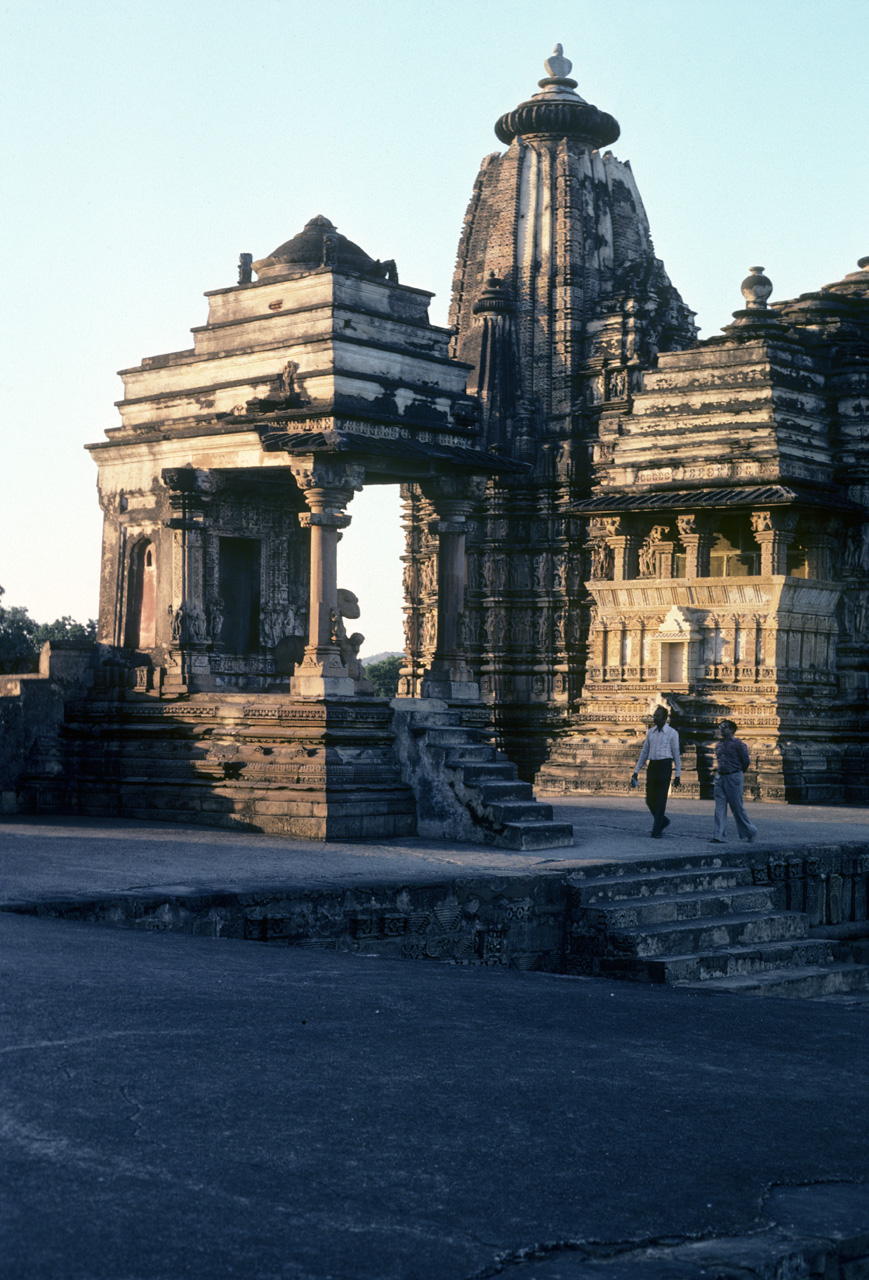


Dulhadev Temple is the last temple of the Southern Group of Temples located in Khajuraho. Constructed in 1130, the temple features classic representation of Chandela art and architecture. Lying on the south of Ghantai Temple and north bank of the Khuddar stream, the temple is a small five chambered shrine with a closed hall.Dedicated to Lord Shiva, the interiors of the temple are decorated with images of Shiva and his wife, Parvati. The intricately carved jewellery work and the fine finishing of the idols portray the skills and workmanship prevalent during that period. The ceilings of the temple are decorated with stone carvings of the Apsaras and other ornamented sculptures.The sanctum of the temple houses a beautiful Shivalinga in the interiors of a closed hall. Developed in traditional style, the temple has many subsidiary shikharas, which are grouped around the central shikhara. Possessing three bands of sculptures, the exteriors of the temple are also beautifully decorated with numerous stone carved images.The images on the exterior band mainly include wizards flying alone and in pairs with their consorts. Swords, playing musical instruments, performing dance and expressions of face are also carved on the walls.



Shanthinath Temple is a famous Jain temple dedicated to Lord Shanthinath, the 16th Jain Tirthankara. The Shanthinath Temple belongs to the eastern group of temples in Khajuraho. A famous Jain temple of Digambar sect, the temple is originally dedicated to Adinath, a Jain saint.The main deity enshrined in this temple is represented in a standing posture, which has a height of about 4.5 m. It is also believed that the idol was constructed in 1028. The temple also houses a dharmasala, which is located in its close vicinity.The temple also has a picture gallery, which displays a vast collection of photos of most significant Jain monuments of India in a chronological order of their establishment.

Archaeological Museum, also known by the name of Jardine Museum, was built by Mr. W.A. Jardine in 1910. The museum is a display centre of the loose sculptures and architectural ruins, which were collected from the temples of Khajuraho.Situated near the Matangeshwar Temple, the museum was constructed with an aim to preserve these artifacts. The open air collection was known as Jardine Museum until 1952, when Archaeological Survey of India took it over and changed its name to Archaeological Museum.Displaying the collection of Khajuraho sculptures in the open air museum, the present museum was established in 1967. It consists of five galleries, including the main hall, showcase antique sculptures of Brahmanical, Jaina and Buddhist faiths. Housing more than 2,000 sculptures, the most prominent one is a seated Buddha figure, which indicates the existence of Buddhist shrine in the destination.Another prominent piece of collection is a four-headed Vishnu, which is also known as Vaikuntha. The idol depicts that the central head is human, while the other three are of Hayagriva, Narasimha and Varaha. One of the popular sculptures in the collection is the idol of Ambika, the Jain goddess, who was seated under a mango tree laden with fruits.



Javari Temple is located near the Brahma Temple and is situated in the east of Khajuraho. Falling under eastern group of Khajuraho, this temple is comparatively smaller and is dedicated to Lord Vishnu. Constructed between 1075 and 1100, the temple displays the ancient Khajuraho architecture. It is believed that the name of the temple is derived from the name of the owner of the land, as no Hindu deity has this title. Being similar in structure with the Chaturbhuj Temple, the holy place stands alone with dimensions measuring 11.88 m in length and 6.4 m in breadth. Representing the beautiful figures of native maidens, the exteriors of this beautiful temple are decorated with numerous complicated carvings. The elaborated entrance and the huge tower of the temple add to its beauty.

Lakshmana Temple is a huge stone temple of Khajuraho, which is dedicated to Lord Vishnu. Possessing the same architecture as that of Kandariya Mahadeva and Vishwanath temples, this temple is considered to be one of the oldest existing temples in western group. Constructed in 930-950 AD, the temple is one of the well preserved temple having a full five-part floor plan and four subsidiary shrines.This east facing temple is famous for housing more than 600 images of gods and goddesses of the Hindu mythology. The platform of the temple is beautifully decorated with patterns of elephants and horsemen carrying out parade. Each corner of this beautiful temple is accompanied with a small shrine and is bordered with fence carvings.Apart from this, scenes of battles, hunting and processions are also engraved on the borders of the platform of the temple. Adorned with images of apsaras, the guardians of directions and other divine creatures, the bands of the temple are divided into 2 instead of 3.The inscription represents dedication of the temple to Vaikuntha, an avatar of Lord Vishnu. God Vaikuntha is distinguished by three heads of man, lion and boar. The image of Vaikuntha corresponds with the image recently installed in the sanctum. The western side of the temple is beautifully decorated with sculptures and the full figures of different forms of women with ornate jewellery.
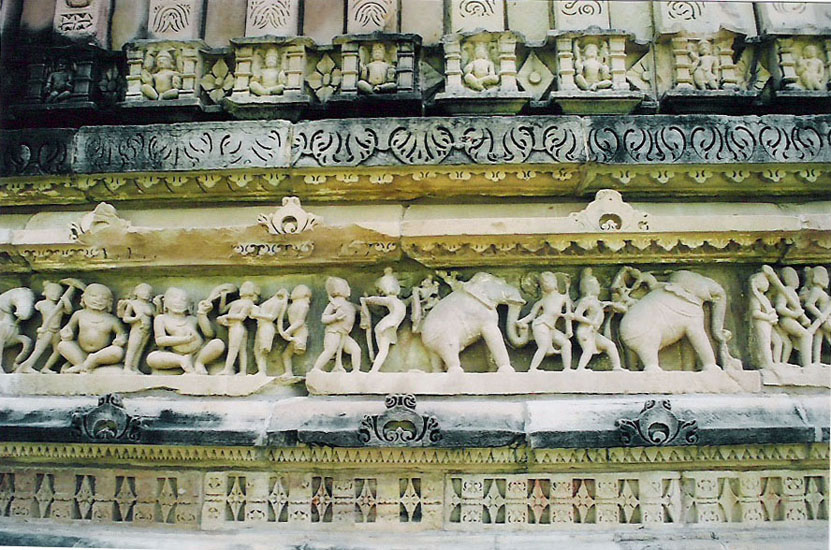
Lakshmi Temple and Varaha Temple are the two small shrines located in the ancient city of Khajuraho. These temples are dedicated to Lord Vishnu and goddess Lakshmi, the Hindu deity of wealth. Belonging to the western group of temples, the shrine depicts moderate sculptures and was built during 900-925 AD. While entering the temple, tourists can witness images of two guards carved on the supporting pillar of the temple.The temple stands at a 10 ft high plain plinth, whose lower half is made of granite ashlars and the upper half is of sandstone. The interiors of the temple are adorned with huge, solid and intricately carved figure of the boar, an incarnation of Lord Vishnu. The idol is carved out of yellow sandstone and is finely finished into a glossy luster The temple is dotted with rows of figures of gods and goddesses more than 674 in number.



Matangeshvara Temple is one of the oldest temples in Khajuraho, which is dedicated to Lord Shiva. Constructed using polished sandstone, the temple houses an 8 ft Shivalinga, which is believed to be among the largest in India. Being one of the plainest temples in Khajuraho, the temple does not feature any intricate carvings and patterns on exteriors or interiors of the temple. Apart from this, the temple also possesses beautiful idols of polished deity, which is also one of the major attractions of the temple.For providing support to the main sanctum, the temple has pillars, which are short and rigid in construction. Further, they also carry plain capitals and brackets, which are not accompanied by any sculptures or carvings. The ceilings of the temple display ornaments of cusps and floral cusps, which are not lined by any borders and elaborations.

Parsvanath Temple is one of the beautiful temples that is under the eastern group of temples of Khajuraho. Dedicated to one of the Jain tirthankaras, the temple is considered to be one of the largest Jain temples present in India. The temple lies in the protected zone of the city and was constructed in around 954 AD. On the basis of sculpture, architecture and inscriptions, it is believed that the temple was dedicated to Adinath, the first Jain tirthankara. Furthermore, it is also believed that the temple was built by Pahila, who was honoured by King Dhanga. The interiors of this beautiful shrine are adorned by the idol of Parsvanath. The temple is famous for housing many non-erotic sculptures, out of which images of surasundaris in various postures are prominent.

Brahma Temple is located on the banks of Khajur Sagar or Ninora Tal. Constructed in 900 AD, the temple houses images of Lord Brahma and Lord Vishnu. Possessing simple plan and architectural design, the temple is made with granite stone and the shikharas are built by using sandstone. It is believed that the temple stands on the twelve pillars of granite, situated on a high platform at an average elevation of 11 ft.Enshrined with a four faced picture of Brahma, the temple originally has been devoted to Lord Vishnu. Evidences for the same can be seen in his figure carved in the doorway of temple. The small temple is known for its display of beautifully carved latticed windows, which are projected on the north and south walls of the temple.

Chaturbhuj Temple was constructed in 1100 AD and belongs to the southern group of Khajuraho temples. This west facing temple stands on a square platform, which can be approached by a staircase of ten steps.The elaborated entrance through the doorway has beautifully carved figures of Brahma, Vishnu and Mahesh. The temple also houses a carved image of 9 ft high, four armed Lord Vishnu. Apart from these, the temple also possesses another incarnation of Vishnu known as the Narasingha avatar and a Shiva's incarnation Ardhanarishvara.Like other temples in the village, it also has a sanctum, a shikhara, an ardhamandapa and the mahamandapa. The three bands of temple are beautifully decorated with images of ashtavasus, dikhpalas, the recesses of mythical lions and nymphs.


Dhubela Museum is situated in an old fort near the banks of a lake on the Jhansi-Khajuraho road. The museum houses a rich collection of artefacts from the ancient as well as from the modern era. The collection displayed in the museum helps tourists to know more about the history, development and decline of the famous Bundela Dynasty of Khajuraho.The vast collection of various sculptures and artefacts helps tourists to understand the lifestyle of the Bundela kings. The sculptures exhibited in the museum belong to the Shakti cult. The wide collection includes weapons, garments and paintings of the Bundela kings.

Raneh Falls is one of the prominent tourist attractions, which is named after King Rane Pratap, the erstwhile ruler of the region. Situated in close vicinity of the destination, the waterfall emerged at the confluence of Ken and Khuddar rivers.Forming 30 m deep and around 5 km long canyon, the falls flow down at the Ken Gharyal Sanctuary. The surroundings of the falls are adorned with crystalline granite, which is present in varying shades ranging from pink, red and grey.



Thanks for providing of nice information.
ReplyDeleteEach store offers an assortment of newly pre-arranged breakfast, lunch, and supper things, specially made sandwiches made from exclusive plans, espresso from the organization's own new mix, dairy merchandise, and wellspring drinks.
ReplyDeleteMywawavisit executed a connected with the WWW review to take an arrangement about Mywawavisit Helpline notwithstanding your support level thereafter visiting service For more info MyWawaVisit.com